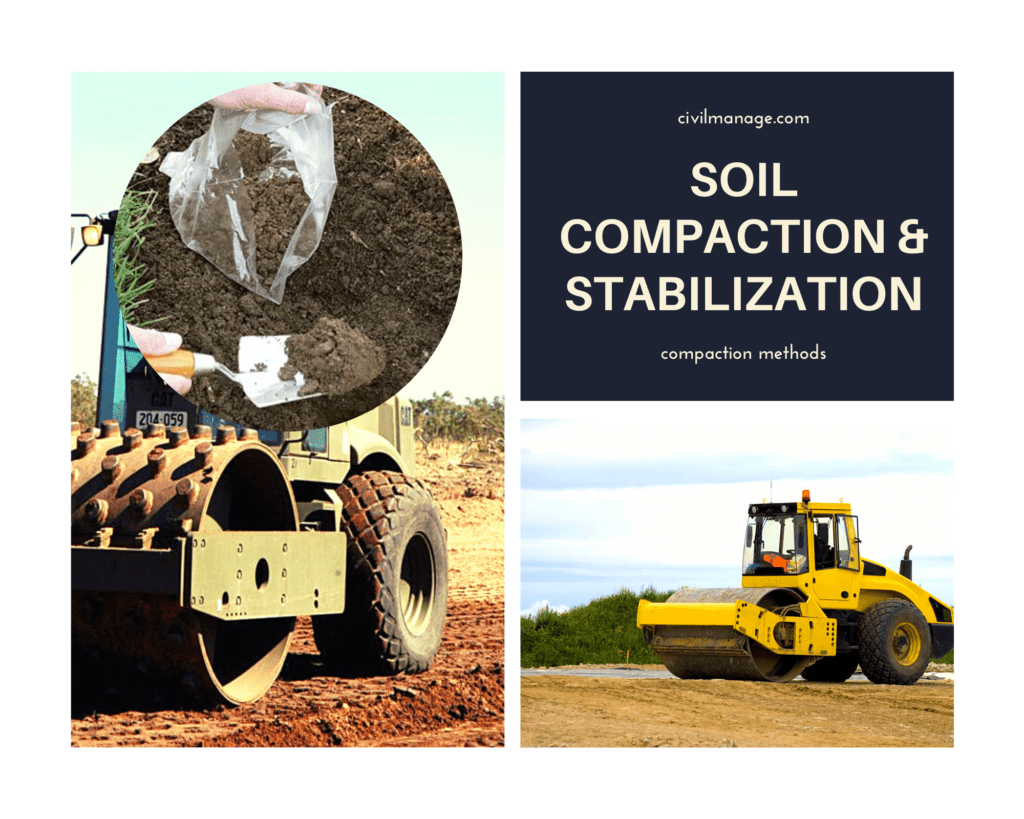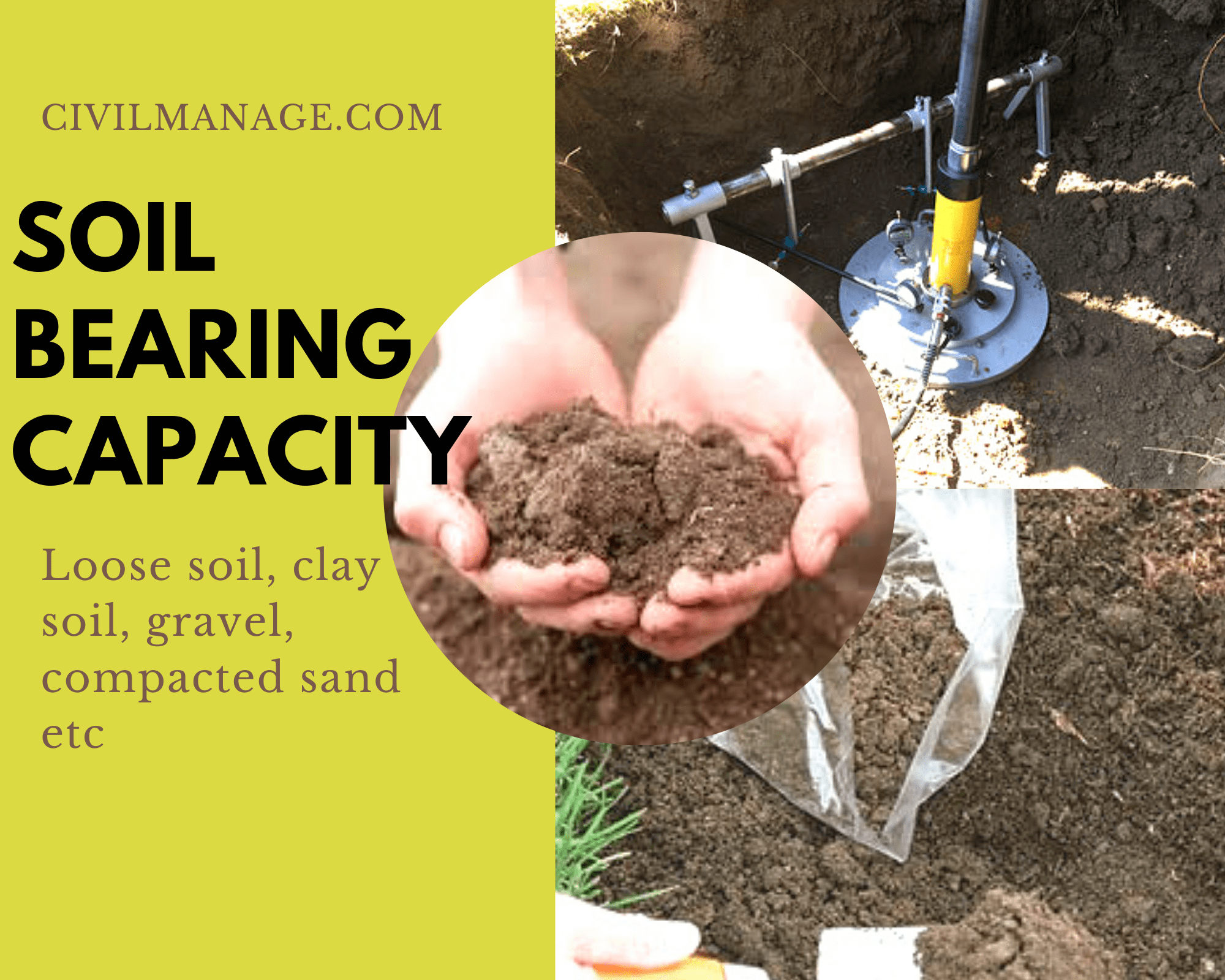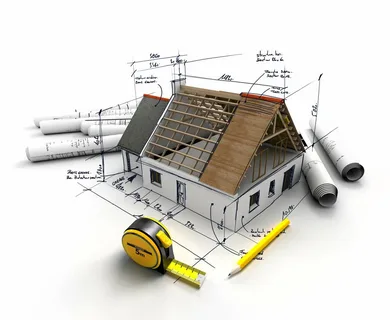In this article, we will discuss about the soil stabilization. Further discuss the bearing capacity and you will learn what is bearing capacity of soil.
Table of Contents
Bearing capacity of soil: Bearing capacity
The capacity of soil to bear the load of structure on per unit area is called bearing capacity of soil. The more bearing capacity soil have, the more it is consider to be suitable for construction.
Because, if the soil is able to bear more load, the foundation design can be simple. Even more this will help to decide the concrete mix grade should be used in sub-structure.
Soil bearing capacity chart:
| Type of soil | Bearing capacity (Kg/m2) | Bearing capacity (KN/m2) |
| Soft, wet/muddy clay | 500 | 50 |
| Soft clay | 1000 | 100 |
| Fine, loose & dry sand | 1000 | 100 |
| Black cotton soil | 1500 | 150 |
| Moist clay & sand clay mixture | 1500 | 150 |
| Loose gravel | 2500 | 250 |
| Medium clay | 2500 | 250 |
| Medium compact and dry sand | 2500 | 250 |
| Compact sand | 4500 | 450 |
| Compact clay | 4500 | 450 |
| Compact gravel | 4500 | 450 |
| Soft rocks | 4500 | 450 |
| Sand stone & Lime stone | 16500 | 1650 |
| Granite & deorite | 33000 | 3300 |
Ultimate bearing capacity of soil?
Without having any deformation, the abaility of soil to bear the maximum load is called UBC. More than that load, the soil start to settle down.
Safe bearing capacity of soil?
There shouldn’t be ultimate pressure/load on soil, because this will result in foundation failure. So that’s why the load should be 1 to 3 times less than ultimate bearing capacity. This 1 to 3 times less pressure than ultimate bearing capacity is called safe bearing capacity.
This (1-3) is called factor of safety (F.O.S). The foundation of structure is designed on safe bearing capacity.
Factors effect bearing capacity of soil:
Following are the factors that affect bearing capacity of soil.
Type of soil:
Some types of soil can bear more load and some of them can bear less as well. As of grainy soil, gravel and sand can beat more load. On the contrary clay and silt have less bearing capacity.
Type of foundation:
The texture and type of foundation also affect the BCS. Spread and raft foundation can transfer more load on soil as compare to other. Also deep foundations transfer more load as compare to shallow.
Physical properties of soil:
physical properties of soil really have effect on BC. As of porous soil can settle soon, while non porous soil can’t be settled down with normal pressure.
Same as, unit weight of soil also affect the bearing capacity. The more unit weight of soil the more it can bear the load.
Water conditions:
The fluctuation of moisture content also have affect on bearing capacity. Presence of ground water, temporarily increase the BC of soil. But the excess amount of water will have bad affects.
How to calculate bearing capacity of soil?
Well there is many ways and methods being introduced to find bearing capacity but the most reliable and effective method that can be done easily is drop weight method.
- First dig a hole till the point where you want to check the bearing capacity. It is preferable to dig down to foundation level.
- Take a cube or ball of known weight and dimensions.
- Now drop the cube/ball on the required hole from a known height.
- Now measure the cube/ball impression depth on soil surface.
》For accurate results, drop the cube/ball several time and then measure the average depth.
Calculate bearing capacity of soil:
- Cube weight= 0.5 kg , Height of fall= 150 cm
- Depth of impression= 0.9 cm
- Cross-section area = A = 25 cm2
- Factor of safety (FOS)= 2
- Ultimate bearing capacity = UR = (0.5 × 150)/0.9 = 83.33 kg
- Safe bearing capacity = 83.33/(25×2) = 1.66 kg/cm2
What to do if soil is weak and have less bearing capacity. Then the soil should be stabilize first.
Soil stabilization: Soil stabilization methods
More often heavy structures built on loose/weak soil. In this case the the bearing capacity of weak soil should be increased. The process of increasing BC is called soil stabilization.
If you are seeking answer to how to increase bearing capacity of soil? Or how to stabilize soil for construction? Following are soil stabilization methods given below to increase the BC of soil.
Increase in foundation depth:
This method is suitable where underground water is avalaible at more depth. This method is most suitable for sandy soil. In this method just the depth of foundation is increased.
To calculate the depth of foundation click here.
Mechanical soil stabilization:
How to stabilize clay soil? Clay and silt can bear less load comparatively. So that to stabilize it, gravel are added in silt and clay and then compact it well. It results in real strong soil.
Push groundwater down:
Ground water is emitted by lineage of pipes in foundation. Beside this, the ground water level is decreased by diggin low depth tube well. This method really increase bearing capacity. This is suitable for sandy soil.
Compaction of soil stabilization:
Compaction reduce the voids between particles, which increase the unit weight of soil, by which bearing capacity increased ultimately.

Surround the weak soil:
In this method, foundation of building is covered with sheet piles, which surround the soil. This will help to increase the bearing capacity. This method is suitable for sandy soil.
Lime stabilization of soil: Soil cement stabilization:
Soil cement stabilization method is used below the foundation on hard rock. In this method cement grout is filled in rock cracks with pressure. This will close the cracks and holes and provide the strong surface for building foundation.
Beside this, lime mixture or asphalt mixture can also help to stabilize the soil and increase the bearing capacity of soil. It is called lime stabilization of soil.
Soil stabilization products:
In this stabilization method, there are use of stabilization products and chemicals, which absorb the moisture from atmosphere and increase moisture content in soil. Which ultimately increase the bearing capacity of soil.
Chemicals that are used for soil stabilization are calcium chloride or silicate of soda, sodium hypocholorite etc.





